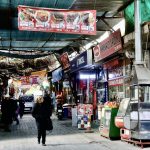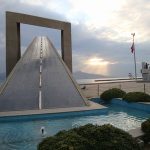“Go to Bayraklı on the Metro,” the archaeologist at the Altınpark Achaeological Park in Basmane had said to me. “I live there so I know it’s easy. Just go straight ahead.”
On previous visits to İzmir I’ve often noticed brown tourist signs pointing to Tepekule, brackets Smyrna, and wondered whether I should follow them up but the guidebooks had little to say about the site and working out the bus network was a mind-boggling task calculated to bring on a head-ache. So it never happened. Until now when I’ve discovered that the Metro has sprouted a second line with a station at Bayraklı. There on the map is a symbol for an archaeological site right beside it. All systems go!
Sort of. I take the Metro and change at Halkapınar for Bayraklı, noticing how smart it all is, with little metal trays sliding out from the side of the new trains to catch anyone who fails to read the “Mind the Gap” signs on the platform (now there’s a job for an out-of-work London Transport announcer). But at the top of the escalator I make a fatal mistake. To the right I can see some ruined buildings. They’re modern but is that the direction in which to head? I ask a security guide.
He points way into the distance. “See that tall building?” he says.
“It looks a long way to walk,” I reply.
“Yes,” he says. “You need Salhane. Quick – the train is on the platform.”
I race back down the escalator. I leap into the train just as the doors are closing. I disembark one stop back at Salhane, ascend the escalator and check with the security guard. Tepekule, he nods. “Yes, there it is,” and he points at the same tall modern building. It looks derelict but on its side I can see the writing. Tepekule, the building is called.
“No, no,” I laugh.” I’m after Old Smyrna. Tepekule. You know, the archaeological site. There are brown signs to it.”
He looks at me blankly and at once I remember so many conversations in İstanbul back when I had been researching Istanbul The Ultimate Guide.
To man sitting on step in front of old building” Do you know what this was?”
“It’s very old, abla.”
“Yes, but what was it?”
Blank look followed by a shrug and a “bilmem (I don’t know)”.
The guard confers with passers-by. Only one of them seems to have the faintest idea what I’m talking about. Bayraklı, he says, so I dash back down the escalator, jump back into the train, head back the way I’ve just come.
At Bayraklı I ask again and receive the same blank stares. Then I glance left along the shopping street and see, at the end, a hill with what looks like a column on it. “Could it be that?” I ask. Nods and looks of relief all round.
And was it worth it? Well, the site of Old Smyrna is certainly not a second Ephesus and I whipped round it nervously. not entirely sure whether I should have been guided by the open gate (open) or the “Izinsiz giremez (Dont Enter Without Permission)”, “Girişe Kapalı (Entrance Closed)” and “Köpek Var (Beware of the Dog)” signs (closed).
But, you know, it really is a site worth seeing if you’re at all interested in the very distant past, a settlement mound dating back to the 7th century BC with traces of a mud-brick wall and then a later stone one, the oldest fountain yet found in the western world, a temple to Athena partially rebuilt with curious capitals like ram’s heads, and remains of houses with crazy-paved floors, a necropolis and much more. Clearly it was once intended that people should visit the site to judge from the informative bilingual signs, the route markers and the metal access ladders. But at the moment it looks as if it’s most common use is as a rubbish tip cum late-night drinking hole which is a shame as it offers a lovely oasis of greenery with vines and olive trees amid the urban blight surrounding it.
And the modern ruins on the other side of the station? Reminders of the terrible fighting that brought Smyrna to its end in 1922. The gateway to one of the houses is filled with a köfte stand on wheels catering for a “cafe” of two or three tables set up in a shed amid more litter. EU hygiene regulations? As unknown here as the way to the ruins. Yet the battered relics of the old stone mansions are now shored up as the first step on the road to gentrification. Next time I visit I fully expect to see them housing upmarket restaurants.
Written: 11 November 2011


